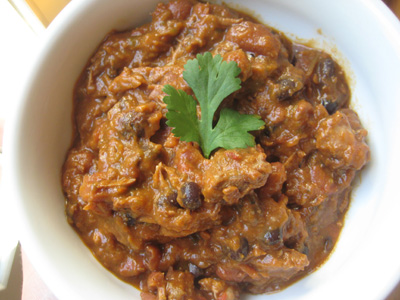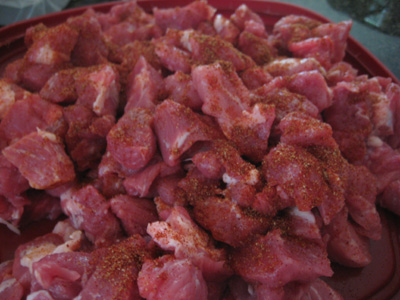Meat
Because it's a stew, the most important ingredient in this dish is the meat. When I make my chili, the meat is the star. I like to use 3/4 beef chuck (cut into pieces, not ground) along with 1/4 pork butt. Using only beef is fine, but I find that the subtle addition of a little pork fat intensifies the meat flavors nicely. Another option is to fry up some bacon and then use the bacon fat to cook the beef. But whatever you use, just be sure not to use lean cuts of meat. Let's face it, chili isn't a diet dish and you really do need some fat to give everything the rich flavor you expect. No turkey!

Chiles
There is a world of chiles out there to explore. Co-starring in my own culinary tale are 6 different types of chile peppers, both dried and fresh varieties. While fresh pasillas, Anaheims, serranos, and jalapenos impart a verdant heat, dried anchos and chipotles in adobo add a rich undercurrent of picante smokiness. You can also experiment with a variety of other dried and fresh chiles. Have fun with this. If you go to the right market, you'll find a world of beautiful chiles out there. And don’t worry if you're not a lover of spicy dishes. There are plenty of mild peppers out there worth exploring.
A note on using dried chiles: Now I realize that using real dried chiles can seem intimidating. For years I stared at dried chiles stacked in Mexican grocery stores or in cellophane bags at my regular market, but was afraid to use them. They seemed mysterious and indecipherable, so I stuck with only powdered chiles. Yet once I realized that you just need to heat them in a dry pan and then soak in some water before pureeing, I mustered up the courage to give them a try. Other than being a little embarrassed to find they were so easy to work with, my maiden voyage using dried peppers was uneventful and I've never looked back.
Tomatoes and Beans (To use or not to use…)
So how about those controversial tomatoes and beans? If you're a purist or a true blooded Texan who wants all meat, then by all means skip these in your chili. That said, before making any major decisions, consider that both add great flavor and texture to the dish. I like to first cook up a batch of dried beans, leaving them al dente so they finish cooking in the chili itself. This allows the beans to soak up the flavors of the stew as they finish cooking. The tomatoes then provide a little sweetness to counterbalance the heat and smoky flavors of the chiles. For me, beans and tomatoes add so much flavor and texture that I can't imagine my chili without them. But the beauty of making your own pot of chili is that you get to decide what you like and don't like, so add them if you want.
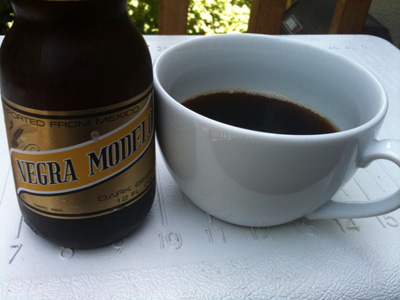
Liquids
Whether you add beans and tomatoes or just use meat and chiles, you will need some sort of liquid so you can simmer everything. As far as I'm concerned, a mixture of both beer and brewed coffee is essential. Beer's yeast and hops introduce a robust full-bodied taste that joins the rest of the stews flavors nicely, while the coffee provides an undertone that accents the overarching spices in a way that vanilla makes chocolate taste more profound.
Other stuff
And, speaking of chocolate, a whisper of cocoa powder or Mexican chocolate, added at the end, helps mellow and fuse the chili's flavors. I also like to add in some masa harina (finely ground corn used to make tortillas) or just some ground corn meal to thicken things up if the chile is too soupy. You can also add other ingredients, like fresh corn, if you'd like.
Time
Making chili is an all-day affair because the ingredients need time to mature and come together. I let everything simmer for 4-5 hours on the stove. If you want, I'm sure you can use a crock pot, although I've never done this myself. Whatever you do, don't hurry the process because you need all those flavors to mature and come together, and only time can do this.
So that's how you make chili. As with many other dishes, the keys to making a great meal are simply a little patience, along with some quality ingredients -- in this case a variety of chiles and stew-sized chunks of meat. If you follow these guidelines, you'll have your own hearty and smoky pot of chili to be proud of.
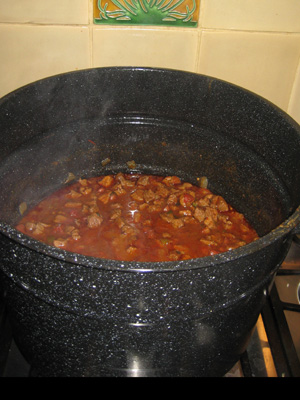
Chili
Makes: One large pot of chili
Ingredients:
3 lbs beef chuck cut into 1/4-inch pieces
1 lb pork butt cut into 1/4-inch pieces
2 Tbsp chile powder (I like chile molido, but any mild chile powder is fine)
1 Tbsp cumin
1 tsp salt
3-4 dried ancho chiles (depending on size)
Corn or vegetable oil for sautéing
2/3 of a 7 oz can chipotle chiles in adobo sauce (use 1 full can if you want the dish extra smoky and spicy)
1 large onion chopped
2 cloves garlic minced
1/2 serrano pepper seeded and minced (use the whole pepper if you like your chili spicy)
1 jalapeño seeded and minced
2 pasilla peppers seeded and chopped small
2 Anaheim peppers seeded and chopped small
1 Tbsp ground cumin (freshly toasted seeds ground at home are best but preground is fine)
1/2 tsp all spice
1 tsp dried ground coriander
1/2 - 1 bottle beer
1 cup coffee
1 15 oz can diced tomatoes or 2 cups freshly chopped tomatoes (no seeds)
2 cups freshly cooked beans (kidney, navy, black or pinto are fine)
1/4 cup masa harina or finely ground corn meal (optional)
1 heaping Tbsp cocoa or 1/4 round grated Mexican chocolate
Preparation:
1. The night before you plan on making your chili, chop up your meat and season with the 2 Tbsp chile powder, 1 Tbsp cumin, and 1 tsp salt. Rub the seasoning all over the meat. Set in the refrigerator overnight.
2. In a dry pan (I like to use a medium cast iron pan) heat your ancho chiles on high, turning every 30 seconds or so until the peppers are warmed through and hot. Add enough water to cover the peppers and then cover the pan and let sit for 30 minutes. Drain pan of water and then puree the peppers in a blender or chopper. Set aside. (If you do this the night before, be sure to refrigerate the puree).
3. Heat a large heavy pot (I like to use a cast-iron dutch oven) on medium high heat. When the pot is hot, add in 1 Tbsp oil and then add in enough meat to mostly cover, but not crowd, the pan. Sear meat on all sides and then remove from pan. Repeat (adding in more oil if necessary) until all the meat is browned. Remove all meat from the pan.
4. Add a little more oil to the pan and then sauté your onions and garlic for a few minutes. Add in the chopped peppers (serranos, jalapeno, pasilla and Anaheim) and cook for 2-3 minutes.
5. Add the meat back into the pan (with the vegetables) and then mix in the pureed anchos, chipotles, tomatoes, cooked beans, cumin, all spice, coriander, beer and coffee. You should have enough liquid to just barely cover the meat, but not so much that the meat is swimming in liquid. Add the other 1/2 of the beer if it looks like you need more liquid.
6. Bring the chili to a soft boil and then cover and set the burner to simmer. Stir at least once an hour, more often if your pan has a thin bottom so you don't burn the stew. Let the mixture simmer for 4-5 hours. Add in some salt after a couple of hours as needed.
7. Once all the flavors have melded, add in the chocolate and stir in.
8. If the chili seems too soupy, or if it's a little too spicy, add in 1/4 cup masa harina or finely ground corn meal that has been mixed with a little water or beer to make a slurry. Mix in thoroughly.
9. Serve with corn bread and whatever sides sound good.
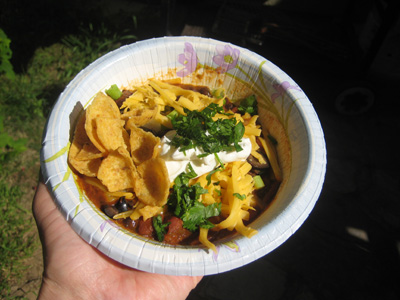
Possible chili sides
